
A sceptre (or scepter in American English) is a staff or wand held in the hand by a ruling monarch as an item of royal or imperial insignia, signifying sovereign authority.

A sceptre (or scepter in American English) is a staff or wand held in the hand by a ruling monarch as an item of royal or imperial insignia, signifying sovereign authority.


The Was and other types of staves were signs of authority in Ancient Egypt. For this reason they are often described as "sceptres", even if they are full-length staffs. One of the earliest royal sceptres was discovered in the 2nd Dynasty tomb of Khasekhemwy in Abydos. Kings were also known to carry a staff, and Pharaoh Anedjib is shown on stone vessels carrying a so-called mks-staff. The staff with the longest history seems[ clarification needed ] to be the heqa-sceptre (the "shepherd's crook").
The sceptre also assumed a central role in the Mesopotamian world, and was in most cases part of the royal insignia of sovereigns and gods. This continued throughout Mesopotamian history, as illustrated in literary and administrative texts and iconography. The Mesopotamian sceptre was mostly called ĝidru in Sumerian and ḫaṭṭum in Akkadian. [1]
The Biblical Book of Genesis refers to the sceptre of Judah.
"The sceptre shall not depart from Judah, nor a lawgiver from between his feet, until Shiloh come; and unto him shall the gathering of the people be."
— Genesis 49:10 KJV [2]
In the First Persian Empire, the Biblical Book of Esther mentions the sceptre of the King of Persia.
"When the king saw Esther the queen standing in the court, she obtained favor in his sight; and the king held out to Esther the golden scepter that was in his hand. So Esther came near, and touched the top of the scepter."
— Esther 5:2
Among the early Greeks, the sceptre (Ancient Greek : σκῆπτρον, skeptron, "staff, stick, baton") was a long staff, such as Agamemnon wielded (Iliad, i) or was used by respected elders (Iliad, xviii. 46; Herodotus 1. 196), and came to be used by judges, military leaders, priests, and others in authority. It is represented on painted vases as a long staff tipped with a metal ornament. When the sceptre is borne by Zeus or Hades, it is headed by a bird. It was this symbol of Zeus, the king of the gods and ruler of Olympus, that gave their inviolable status to the kerykes, the heralds, who were thus protected by the precursor of modern diplomatic immunity. When, in the Iliad, Agamemnon sends Odysseus to parley with the leaders of the Achaeans, he lends him his sceptre.
Among the Etruscans, sceptres of great magnificence were used by kings and high priests. Many representations of such sceptres occur on the walls of the painted tombs of Etruria. The British Museum, the Vatican, and the Louvre possess Etruscan sceptres of gold, elaborately and minutely ornamented.
The Roman sceptre probably derived from the Etruscan. Under the Republic, an ivory sceptre (sceptrum eburneum) was a mark of consular rank. It was also used by victorious generals who received the title of imperator , and its use as a symbol of delegated authority to legates apparently was revived in the marshal's baton.
Under the Roman Empire, the sceptrum Augusti was specially used by the emperors, and was often of ivory tipped with a golden eagle. It is frequently shown on medallions of the later empire, which have on the obverse a half-length figure of the emperor, holding in one hand the sceptrum Augusti, and in the other the orb surmounted by a small figure of Victory.

The codes of the just and the cruel sceptre are found in the ancient Tamil work of Tirukkural , dated before 5th century CE. In its chapters 55 (Sengol) and 56 (Kondungol), the text deals with the just and the cruel sceptre, respectively, furthering the thought on the ethical behaviour of the ruler discussed in many of the preceding and the following chapters. [3] [4] The ancient treatise says it was not the king's spear but the just sceptre, known as "Sengol" in Tamil, [5] that bound him to his people—and to the extent that he guarded them, his own good rule would guard him. [6] It was a practice of ancient Indian kingdoms and dynasties, such as the Chola kings, to use a symbolic sceptre during coronations. [7]
One such sceptre was presented to Jawarhal Nehru on 14 August 1947 by the Thiruvavaduthurai Adheenam symbolising the transfer of power as followed by Ancient Hindu kings. [8] It was displayed in the Allahabad Museum under the then Indian government wrongly marked as 'Golden walking Stick Gifted to Pt Jawahar Lal Nehru'. [9] [10] In 2023, the government of India decided to install this golden sceptre, Sengol in the newly inaugurated Indian Parliament. The presentation of the sceptre to the first Indian Prime Minister in 1947 was claimed as a 'symbol of transfer of power from British to India', [11] which has been stirred up debates among few historians, who point to the lack of sources that portray the event as an official event. [12]


With the advent of Christianity, the sceptre was often tipped with a cross instead of with an eagle. However, during the Middle Ages, the finials on the top of the sceptre varied considerably.[ citation needed ]
In England, from a very early period, two sceptres have been concurrently used, and from the time of Richard I, they have been distinguished as being tipped with a cross and a dove respectively. In France, the royal sceptre was tipped with a fleur de lys , and the other, known as the main de justice, had an open hand of benediction on the top.[ citation needed ]
Sceptres with small shrines on the top are sometimes represented on royal seals, as on the great seal of Edward III, where the king, enthroned, bears such a sceptre, but it was an unusual form; and one of the sceptres of Scotland, preserved at Edinburgh, has such a shrine at the top, with little images of the Virgin Mary, Saint Andrew, and Saint James the Great in it. This sceptre was, it is believed, made in France around 1536 for James V. Great seals usually represent the sovereign enthroned, holding a sceptre (often the second in dignity) in the right hand, and the orb and cross in the left. Harold Godwinson appears thus in the Bayeux Tapestry.[ citation needed ]
The earliest English coronation form of the 9th century mentions a sceptre (sceptrum), and a staff (baculum). In the so-called coronation form of Æthelred the Unready, a sceptre (sceptrum), and a rod (virga) appear, as they do also in the case of a coronation order of the 12th century. In a contemporary account of Richard I’s coronation, the royal sceptre of gold with a gold cross (sceptrum), and the gold rod with a gold dove on the top (virga), enter the historical record for the first time. About 1450, Sporley, a monk of Westminster, compiled a list of the relics there. These included the articles used at the coronation of Saint Edward the Confessor, and left by him for the coronations of his successors. A golden sceptre, a wooden rod gilt, and an iron rod are named. These survived until the Commonwealth, and are minutely described in an inventory of the regalia drawn up in 1649, when everything was destroyed.[ citation needed ]
For the coronation of Charles II of England, new sceptres with the Cross and the Dove were made, and though slightly altered, they are still in use today. Two sceptres for the queen consort, one with a cross, and the other with a dove, have been subsequently added.[ citation needed ]
The flags of Moldova and Montenegro have sceptres on them, clasped by eagles.

Pharaoh is the vernacular term often used for the monarchs of ancient Egypt, who ruled from the First Dynasty until the annexation of Egypt by the Roman Republic in 30 BCE. However, regardless of gender, "king" was the term used most frequently by the ancient Egyptians for their monarchs through the middle of the Eighteenth Dynasty during the New Kingdom. The earliest confirmed instances of "pharaoh" used contemporaneously for a ruler were a letter to Akhenaten or an inscription possibly referring to Thutmose III.

Crown jewels are the objects of metalwork and jewellery in the regalia of a current or former monarchy. They are often used for the coronation of a monarch and a few other ceremonial occasions. A monarch may often be shown wearing them in portraits, as they symbolize the power and continuity of the monarchy. Additions to them may be made, but, since medieval times, the existing items have been typically passed down unchanged, symbolizing the continuity of a monarchy.
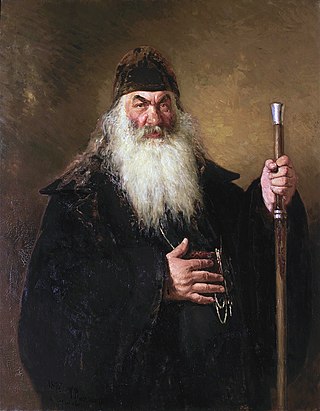
A staff of office is a staff, the carrying of which often denotes an official's position, a social rank or a degree of social prestige.

A ceremonial mace is a highly ornamented staff of metal or wood, carried before a sovereign or other high officials in civic ceremonies by a mace-bearer, intended to represent the official's authority. The mace, as used today, derives from the original mace used as a weapon. Processions often feature maces, as on parliamentary or formal academic occasions.

A wand is a thin, light-weight rod that is held with one hand, and is traditionally made of wood, but may also be made of other materials, such as metal, plastic or stone. Long versions of wands are often styled in forms of staves or sceptres, which could have large ornamentation on the top.

The Crown Jewels of the United Kingdom, originally the Crown Jewels of England, are a collection of royal ceremonial objects kept in the Jewel House at the Tower of London, which include the coronation regalia and vestments worn by British monarchs.

The Holy Crown of Hungary, also known as the Crown of Saint Stephen, named in honour of Saint Stephen I of Hungary, was the coronation crown used by the Kingdom of Hungary for most of its existence; kings were crowned with it since the twelfth century. The Crown symbolized the King's authority over the Lands of the Hungarian Crown, and it was a key mark of legitimacy. Through the history of Hungary, more than fifty kings were crowned with it, with the last being Charles IV in 1916. The only kings not so crowned were Wladyslaw I, John Sigismund Zápolya, and Joseph II.

The globus cruciger, also known as stavroforos sphaira or "the orb and cross", is an orb surmounted by a cross. It has been a Christian symbol of authority since the Middle Ages, used on coins, in iconography, and with a sceptre as royal regalia.
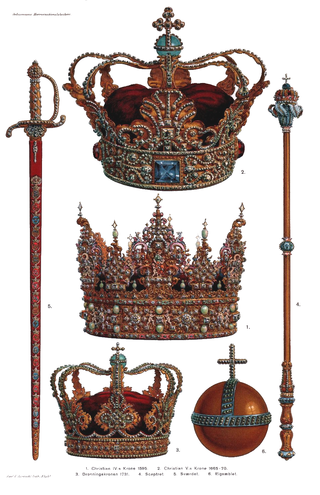
Danish Crown Regalia are the symbols of the Danish monarchy. They consist of three crowns, a sceptre, globus cruciger, the sword of state and an ampulla . The Danish Royal Regalia are kept in the treasury at Rosenborg Castle. The oldest of these is Christian III's sword of state from 1551. They further include King Christian IV's diamond; pearl- and gold-embroidered saddles; objects carved from ivory and rock-crystal; lapidary pieces of precious stones, and brooches in the form of fantastic animals.

The regalia of Norway are items that symbolise the Norwegian monarch's power and majesty. Little is known of the old Norwegian regalia which have since been lost. The majority of the modern regalia date from 1818 and were made for the coronation of Jean Bernadotte as King Carl III Johan.
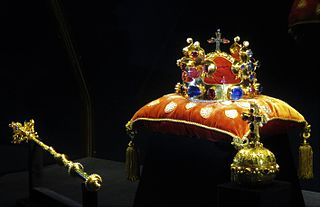
The Bohemian crown jewels, also called the Czech crown jewels, include the Crown of Saint Wenceslas, the royal orb and sceptre, the coronation vestments of the Kings of Bohemia, the gold reliquary cross, and St. Wenceslas' sword. They were originally held in Prague and Karlštejn Castle, designed in the 14th century by Matthias of Arras. Since 1791 they have been stored in St. Vitus Cathedral at Prague Castle. Reproductions of the jewels are permanently exhibited in the historical exposition at the former royal palace in the castle. The crown was made for the coronation of Charles IV in 1347, making it the fourth oldest in Europe.
The Royal Crown of Serbia is a royal regalia that existed during the Serbian monarchy.
The Regalia of Romania are a set of items which were used for the coronation of the kings and queens of Romania. They are currently housed in the National Museum of Romanian History in Bucharest. The regalia consist of the Royal Crown, the Crown of Queen Elizabeth, the Crown of Queen Maria, orbs, the Scepter of King Ferdinand I the Scepter of King Carol II, the Sword of King Carol I and the Royal Mantle.

Sweden's regalia are kept deep in the vaults of the Royal Treasury, underneath the Royal Palace in Stockholm, in a museum that is open to the public. The crowns and coronets have not been worn by Swedish royalty since 1907, but they are still displayed at weddings, christenings and funerals.

The Holy Roman Emperor received the imperial regalia from the hands of the Pope, symbolizing both the pope's right to crown Christian sovereigns and also the emperor's role as protector of the Catholic Church. The Holy Roman empresses were crowned as well.
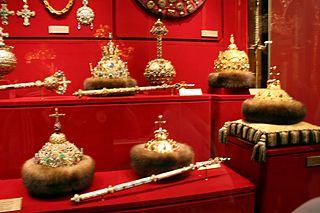
Regalia of the Russian tsars are the insignia of tsars and emperors of Russia, who ruled from the 13th to the 19th century. Over the centuries, the specific items used by Tsars changed greatly; the largest such shift occurred in the 18th century, when Peter the Great reformed the state to align it more closely with Western European monarchies.

Coronations were previously held in the monarchies of Europe. The United Kingdom is the only monarchy in Europe that still practises coronations. Other European monarchies either have replaced coronations with simpler ceremonies to mark an accession or have never practised them. Most monarchies today only require a simple oath to be taken in the presence of the country's legislature.
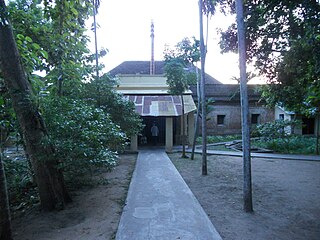
Thiruvavaduthurai Adheenam is a Saivite mutt, based in the town of Thiruvavaduthurai in Kuthalam taluk of Mayiladuthurai District, Tamil Nadu, India. The adheenam maintains the Mayuranathaswami temple at Mayiladuthurai. As of 1987, there were a total of 15 Shiva temples under the control of the adheenam.
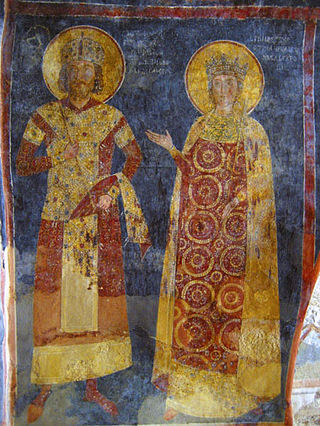
There are no known surviving pieces from the royal regalia of the First and Second Bulgarian Empires. A gift of regalia to Kaloyan of Bulgaria from Pope Innocent III is documented. It was brought to Bulgaria by Cardinal Leo Brancaleoni and was used for the Coronation of the Bulgarian monarch on November 8, 1204.
The Sengol is a gold-plated, silver sceptre that is installed in New Parliament House in New Delhi, India. The sceptre was originally gifted to Jawaharlal Nehru, the first Prime Minister of India, by a Tamil Adheenam in a religious ceremony on the evening before the Independence of India in 1947. The Sengol was housed at Allahabad Museum for seventy years until it was moved to its present location upon the building's inauguration by Prime Minister Narendra Modi in 2023.